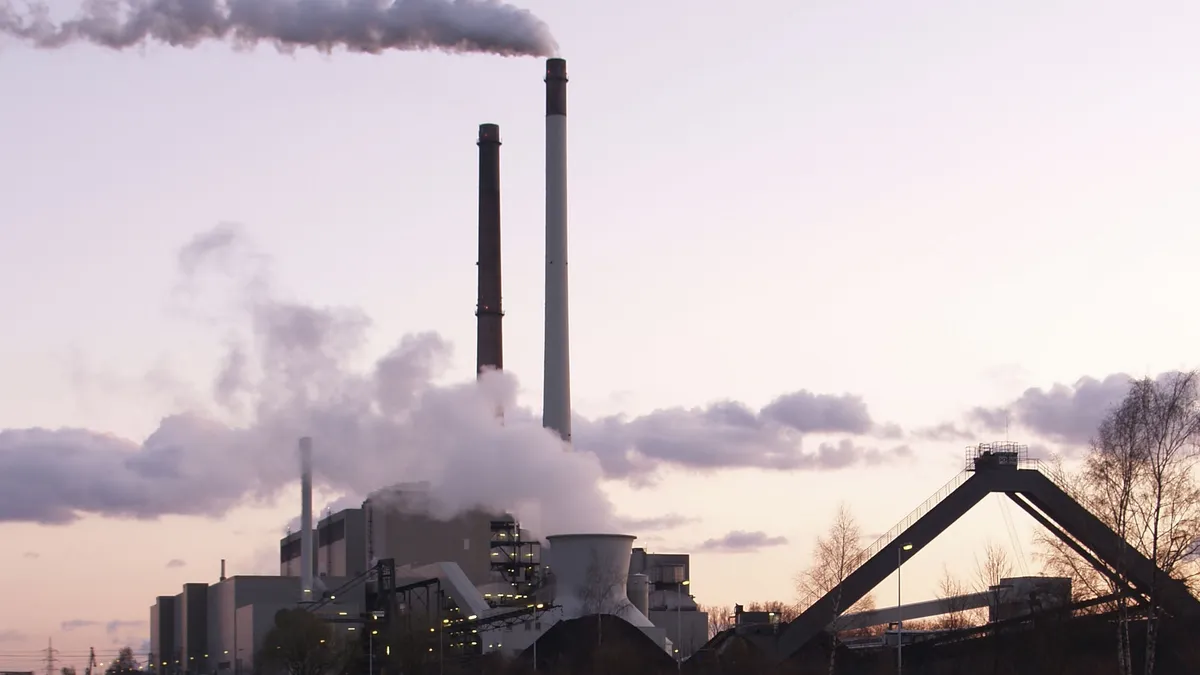Dive Brief:
-
Carbon dioxide (CO2) emissions from the U.S. electric power sector fell 8% between 2018 and 2019, a result of an increasingly rapid shift away from coal-fired power, according to a report released Wednesday from Ceres.
-
The drop in emissions followed a slight uptick the year before — from 2017 to 2018, power sector CO2 emissions rose 1%, due to accelerated natural gas additions. Ceres also found that of the 100 largest U.S. power producers, Vistra Corp., Duke Energy and Southern Company produced the most carbon emissions in 2018.
-
Progress in 2019 is a cause for optimism, report author and Senior Director of Electric Power at Ceres, Dan Bakal, told Utility Dive, though the sector will need to move even faster in order to offset the worst impacts of climate change.
Dive Insight:
The 100 largest power producers in the U.S. are responsible for more than 80% of the electric power sector's emissions and generation, which in turn made up about 32% of total U.S. carbon emissions, 48% of sulfur dioxide (SO2) emissions, 11% of nitrogen oxide (NOx) emissions and 24% of mercury emissions in 2018, Ceres found.
Broadly, the U.S. power sector has reduced carbon emissions 30% since the sector's peak in 2007, the report said, and a continued decline in emissions in 2019, even with economic growth, was encouraging, according to Bakal.
That success can largely be attributed to a growth in renewable energy, as well as a decrease in coal-fired generation among the leading U.S power producers.
While Duke was a top carbon emitter in 2018, the company pointed to longer term trends.
"Duke Energy is a leader in emissions reductions, reducing carbon 39% from 2005 levels. This is well ahead of the industry average," Duke spokesperson Phil Sgro told Utility Dive. "We are constantly working to progress our ambitious climate goals and make changes to our generation mix to make further significant cuts to our emissions. As an example, we recently set a goal of doubling our renewables portfolio by 2025 — aiming to increase from 8,000 MW to 16,000 MW."
Duke, Vistra and NextEra are the three largest power producers in the U.S. in terms of annual generation, with Duke producing over 200 million MWh of electricity in 2018 alone. But NextEra's power mix includes higher levels of carbon-free energy — 23% of its mix is made up of renewable energy and 27% comes from nuclear power — putting it ninth in carbon emissions produced in 2018, while the resource mixes of Duke, Vistra and Southern Company all include more coal, although that is changing.
"It's important to note that much has changed since 2018 — Vistra has retired or announced the retirement of nine coal plants since January 2018, with more closures expected," Vistra Chief Sustainability Officer and Vice President of Investor Relations Molly Sorg told Utility Dive in an email. Sorg noted the company was also not the worst offender when considering pounds of emissions per MWh, a second calculation Ceres used to examine the efficiency of a plant and its emissions control technology.
Ultimately, the utility has reduced its portfolio from 70% coal to less than 20%, she said.
"The electric system in the U.S. is undergoing a transformation to low-to-no carbon technologies, but this transformation will take time and will require a diverse set of generation resources if we are to maintain reliability and affordability," she added. "Given the limitations of current technologies, most notably the intermittency of renewables and charge life for batteries, the electric system will require some level of carbon-emitting generation resources for a number of years to maintain reliability and affordability."
Vistra leading the way in 2018 is likely due to its rapid expansion into fossil fuel assets through acquisitions over the past several years, said Bakal.
"This was the first time that Vistra energy ended up as the top emitter of CO2. And that has to do with their mergers and acquisitions, where they acquired a pretty good amount of fossil assets over a several year period," he said.
Vistra also led the way in total mercury emissions and SO2 emissions, trailing Duke in only NOx emissions.
SO2 contributes to acid rain, while NOx causes smog and poor air quality, and mercury is a potent neurotoxin. An additional benefit to a decrease in coal-fired power is the further reduction in these pollutants, said Bakal — particularly because even replacement fuels that continue to emit carbon, like natural gas, emit fewer of these pollutants.
Federal policies have successfully limited these pollutants further, although the Trump Administration in April determined that regulating mercury and other pollutants from power plants is not "appropriate and necessary," a move that critics say could undermine the power sector's efforts to control pollutants.
But Bakal says although the administration's efforts "are not helpful" to reducing emissions, "they are not likely to be increasing coal-fired generation because the economics are so heavily stacked against it."
"The good news is that the majority of all of these emissions come from coal fired generation," he said. "And coal-fired generation is no longer economic. It's being retired and it's going to continue to be retired."















